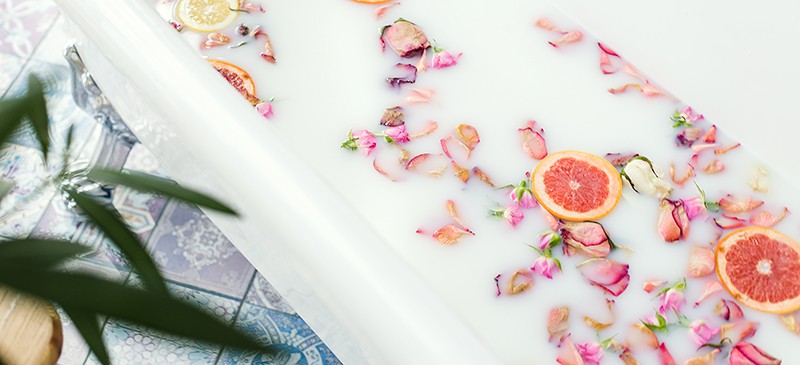
What Is a Milk Bath?
A milk bath is exactly what the name implies — a bath with milk, and usually other natural ingredients. Adding milk to your bath water can help to hydrate and soothe your skin, improve inflammatory skin conditions and promote healthy aging.
Types
The benefits of a milk bath will vary depending on the type of milk you choose to use. Although Cleopatra used donkey’s milk in her baths, there are definitely some other nourishing options out there, and many of them of plant-based. Here’s a rundown of the best milks for your at-home milk bath:
1. Coconut Milk
Coconut milk contains lauric acid, a medium-chain fatty acid that has antimicrobial properties and supports skin health. Just like applying coconut oil topically, coconut milk has moisturizing and anti-inflammatory effects. It may even help with wound healing and increasing the turnover of collagen, which is a proven benefit of coconut compounds.
2. Oat Milk
Have you ever heard of an oatmeal milk bath? It’s usually a combination of milk and ground oats. Some oatmeal milk bath recipes call for coconut milk, some call for cow’s milk — but why not make it with vegan-friendly, nutrient-rich oat milk? It’s a gentle, soothing milk that will promote healthy aging and improve common skin issues like dry skin and eczema.
3. Almond Milk
Try an almond milk bath to soothe, hydrate and restore your skin. Because almond milk is rich in fatty oils, it leaves your skin feeling soft and supple. It’s also a great plant-based option that’s easy to find in your local grocery store.
4. Goat Milk
Goat milk contains lactic acid, which helps to break down dead skin cells and leaves your skin feeling smoother. It also works to moisturize your skin, reduce inflammation and improve acne because of its anti-bacterial properties.
Have you ever tried goat milk soap? If so, you know how nourishing it can be to dry skin — so imagine what soaking your entire body in goat’s milk can do.
5. Buttermilk
Buttermilk is a good source of lactic acid. Research suggests that applying lactic acid topically increases skin firmness and thickness, and improves skin smoothness. Lactic acid also works as an exfoliating agent that helps to remove dead skin cells.
Taking a buttermilk bath can help to reduce the appearance of fine lines and wrinkles and promote healthy aging.
6. Breast Milk
If you’re looking to make a milk bath for baby, human breast milk is the best choice. Studies show that applying breast milk topically has anti-inflammatory effects and can be used to treat skin problems like eczema and diaper rash.
How to & Milk Bath Recipe
Step One — Run hot water: You want to create a relaxing environment, so get that warm to hot water running, dim the lights and maybe light some candles, too.
Step Two — Pour in your milk of choice: You can add milk to your milk bath in two ways — simply pouring milk right into the bath water or using powdered milk. Either way, you’ll want to use 1—2 cups, depending on how much water you have in your bath.
Step Three — Choose your add-ons: There are many plant-based ingredients that you can add to your bath water for their healing, nourishing effects. Many milk bath recipes include a carrier oil and essential oils. Some commonly used milk bath add-ons include:
- Carrier Oils
- coconut oil
- jojoba oil
- sweet almond oil
- arnica oil
- avocado oil
- pomegranate seed oil
- Essential Oils
- lavender
- rose
- frankincense
- chamomile
- clary sage
- grapefruit
- geranium
- Other Add-Ons:
- epsom salts
- baking soda
- honey
Step Four — Relax: Now that you’ve made your own soothing milk bath, it’s time to lay back and enjoy. With the constant pressures and stressors of modern day life, this is the perfect way to unwind while promoting beautiful and healthy aging.
DIY Milk Bath Recipe
Here’s an example of how to create a milk bath with milk and other beneficial ingredients. Simply combine the ingredients in your warm-hot bath water and enjoy.
- 2 cups of buttermilk
- 1 cup of epsom salts
- ½ cup baking soda
- 1 teaspoon of jojoba oil
- 5 drops of lavender essential oil
- 5 drops of rose essential oil
Where to Buy
As milk baths become more popular, many brands are selling bottled or jar milk bath concoctions. You can easily purchase pre-made milk bath products online or at a store like Whole Foods.
If you plan to use milk powder for your bath, you can also find that online or in some grocery stores.
Benefits
Although there’s very limited research on the benefits of milk baths, the beauty method is becoming more and more popular. It’s believed that milk baths help to:
- soothe and hydrate skin
- reduce fine lines and wrinkles
- exfoliate skin
- improve skin firmness
- reduce dry spots and flare-ups
- ease sunburn
- improve inflammatory skin conditions
- ease tension
- relieve stress
- promote restful sleep
Risks
People with a milk allergy should avoid milk baths. Simply coming into contact with milk can lead to allergy symptoms like itchy skin, rash and even hives. Opting for a plant-based milk may be a safe alternative if you know that you aren’t allergic to that type of milk.
For the lactose-intolerant, taking a milk bath is likely safe because it’s not being ingested. To be sure, try a patch test with the milk you’d like to use first to be sure it won’t cause any adverse skin reactions. You can also go with a lactose-free milk, like coconut or almond milk.
If you’re making a milk bath for baby, skip the essential oils and other add-ons, like honey and salts. Simply add breast milk and warm water.
Final Thoughts
- Milk baths are trending — and for good reason. They are nourishing, soothing and hydrating for your skin. Plus, baths made with mood-boosting essential oils can help you to unwind after a long day or week.
- There are many types of milk baths, depending on the ingredients you use. From plant-based milks like almond and coconuts to buttermilk — each type of milk offers a range of skin-boosting benefits.
- To bathe in milk, simply add 1–2 cups of your milk of choice and choose a few add-on ingredients to set the right mood. Some great options are coconut oil, lavender essential oil, frankincense essential oil, baking soda and epsom salts.
Source: Dr. Axe
Don’t Forget to Share and Follow us across our social channels to get the latest, on Facebook , Twitter .




